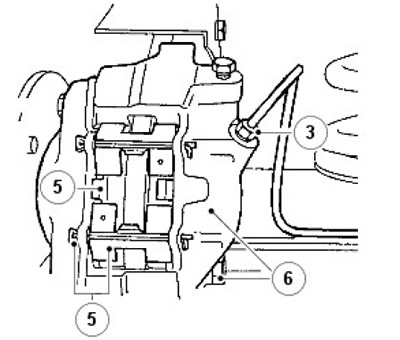Removing
1. Remove rear wheels.
2. Using a suitable brake hose clamp, pinch the flexible brake hose over the rear axle.
3. Remove the brake line from the rear brake caliper.
4. Plug the ends of the line to prevent dirt from entering.
5. Remove pins of fastening and springs and take blocks. If the same pads need to be reinstalled, mark them to reinstall them in their original position.
6. Unscrew 2 bolts and remove a support from the back bridge.

WARNING: Do not separate caliper halves.
7. Clean the outer surfaces of the caliper with an aerosol brake cleaner.
8. CAREFULLY force the pistons out of their bores by applying pressurized air to the brake fluid inlet port. It is unlikely that both pistons will be forced out at the same time, adjust the degree of displacement with a suitable piece of wood inserted between the two pistons.

9. Finally, remove the pistons by marking according to their bores.
10. Remove the wiper holder by inserting a blunt screwdriver between the holder and the wiper. Gently lift the holder from the entry end of the hole.
11. Being careful not to damage the sealing grooves, remove the wiper and fluid seal.
Installation
1. Using only clean brake fluid, clean bores, pistons, and especially sealing recesses. If the caliper or pistons are rusty or not in perfect condition, new elements must be installed.
2. Apply brake fluid to new seals. Fit the seals into the recesses in the holes. When the seal is installed, it feels slightly protruding from the edge of the inlet end of the hole.
3. Apply brake fluid to the pistons. Insert them into the holes without skew. While inserting, do not tilt the pistons and let them protrude from the holes by approximately 8 mm.
4. Apply brake fluid to the new wipers and install them in the holders. Slide cuff assembly with holders (cuff first) above the protruding piston into the recesses of the holes.
5. Use the special tool LRT-70-500 Piston Clamp to press the collar holder and piston into place. Follow the same procedure to install the outer pistons and seals.
6. Install the calipers and pads on the car.
7. Install the caliper on the bridge, tighten the bolts evenly (tightening torque 82 Nm).
8. Connect the brake line to the caliper. Tighten (tightening torque 15 Nm).
9. Remove a collar from a flexible brake hose.
10. On vehicles prior to model year 2002, insert the chocks and retainer springs, secure in place with new studs and flared ends, or install new cotter pins, depending on vehicle model.

11.
NOTE: Vehicles manufactured since model year 2002 have front and rear edge chamfers on the rear pads.
On vehicles from model year 2002, make sure the shims are properly installed. See drawing.

12. Remove air from the brake system.
For more information, refer to the chapter: Bleeding the brake system (206-00 Brake system - General information, General procedures).
13. Fully depress the brake pedal several times to lock the pads into place.
14. Install the wheels, remove the axle supports. Finally, tighten the wheel nuts to the correct torque:
- 1. Light alloy wheels - tightening torque 130 Nm.
- 2. Steel wheels - tightening torque 100 Nm.
- 3. Heavy Duty Wheels - Torque 170 Nm.
15. Carry out a road test. Note: new brake pads require "lapping" for several hundred kilometers before the brakes begin to work at maximum efficiency.
Comments on this article